Description
Railroad Short Name: CP
Enticed by the promises of improved train handling and reduced maintenance costs, more and more railroads took notice and joined the A.C. revolution. Eventually, as operating practices evolved, ACs would find themselves in services beyond the heavy-tonnage applications they were originally envisioned for. As piggyback traffic dwindled and heavier double-stack container trains became more prevalent, AC4400s started finding their way onto those trains, where again their performance characteristics proved their value. As older power was retired or cascaded down into more secondary duties, ACs were finding themselves on just about every service on the railroad.
By the time domestic AC4400 production ended in 2004, nearly every Class 1 railroad had ordered examples of AC4400s except for Norfolk Southern (NS). Ever the holdout, NS avoided safety cabs and AC-traction as long as possible. Instead, they would purchase standard-cab DASH 9s as well as large numbers of its safety-cab equipped version, the C40-9W. Into the 2000s however, NS would eventually acquire AC-traction locomotives, and were impressed with their performance. So much so, they would embark on a rebuilding and upgrading program for their older DASH 9 locomotives, dubbing them “AC44C6M” (AC traction, 4,400hp, C for six axles, the number 6 to signify the number of traction motors, and M for “Modified”). They would have their cabs replaced with the latest GE safety cab design, plus new electrical systems, and components upgraded to AC4400 standards.
In recent years, railroads such as Canadian Pacific, CSX, and Union Pacific have embarked on rebuilding programs for their AC4400 fleets. These programs replace worn out or obsolete components, plus upgrading various systems to improve performance. While examples of the competing EMD product have not been as fortunate. In fact, some have already been retired and scrapped. Aside from wreck victims, nearly all AC4400s are still in service. With rebuild and upgrade programs, they will likely be in service for many years to come.
Road Number Specific Features:
- Era: 1997 to Present
- Series 9600 to 9683; built 9/97 – 1/98
- Road numbers 9604, 9625, 9637, 9641 and 9658
- Standard CP beaver scheme
Features:
- Fully-assembled
- Multiple road numbers
- No truck ground lights (prototype not equipped)
- Operating LED-illuminated front, rear, and side walkway lights*
- Operating LED-illuminated front deck-mounted ditch lights**
- Printed low-mount cab number boards with separately controlled backlit LED-illumination*
- Tall snowplow with open doors and two (2) grab irons
- Semi-scale coupler buffer equipped with durable metal semi-scale Type E knuckle couplers
- 5-step stepwells with see-through steps
- Walkway with front anticlimber
- GE “nub” pattern walkway tread
- Narrow profile end handrails
- Front deck mounted live MU cable connections and dual pilot face dummy MU cable connections; rear pilot face mounted single live and dummy MU cable connections with rear pilot face mounted snowplow connection
- Front nose headlight
- Nose door with window and vertical grab iron
- Two-piece nose top grab irons
- Battery cabinet access door without latch
- GE safety cab with three (3) side windows
- Right side cab under floor access doors: four screened louver sections per door
- Left side cab under floor access doors: bolted panel forward of the HVAC unit
- Cab interior with detailed back wall and front dash, high-back seats, conductor’s workstation, and engineer’s desktop controls
- Tinted cab side windows
- Tall mirror mounted in front of sliding cab side windows on both sides; additional small mirror on right side
- Three (3) large Sinclair “ice skate” communication antennas; small Sinclair “ice skate” End of Train (EOT) telemetry antenna
- Early inverter cabinet: six (6) tall vertical rectangular bolted panels and three (3) horizontal short panels
- Continuous reinforcement rib under dynamic brake intake grilles
- Standard dynamic brake exhaust (2-port)
- Forward right-side air intake grille
- Left side auxiliary cab: three (3) medium doors with latches on the #2 door
- Capacitor box on left side walkway
- Right side auxiliary cab: four (4) doors with latches on #1 and #4 doors
- Late angled engine cab profile with raised “dot” treadplate on centerline
- Lost-wax brass cast Nathan AirChime K3LAR2 horn mounted on engine cab
- Late non-flanged exhaust stack housing
- “Bathtub” exhaust silencer
- 26 individually-applied etched metal see-through radiator intake and exhaust grilles on sides and top of radiator compartment
- Late radiator door grilles in alternating heights
- Standard brake wheel
- Left rear hood door grille arrangement: tall, short, tall grilles
- High-mounted rear sand fill
- Early “box” lifting lugs on ends of radiator wings
- Accurately profiled frame with separately-applied plumbing and traction motor cabling
- Early GE Steerable Trucks
- Rotating axle bearing caps
- No speed recorder
- Dual Graham-White (Prime) 975-075 air filters
- Graham-White 994-500 series air dryer
- 5,000-gallon fuel tank with vertical weld seams
- Single fuel fills per side
- Round and vertical analog fuel gauges; digital fuel gauges
- Fuel tank mounted steel bell
- Separate air tanks with lower mounting brackets, connector pipe, and connector pipe cover
- Early square handbrake chain bracket
- Spare coupler knuckle holders on rear pilot face
- Factory-applied detail parts: wire grab irons, spare knuckles, trainline hoses with silver gladhands, 3-hose MU clusters with silver gladhands, uncoupling levers, windshield wipers, mirrors, sunshades, and more
- Motor with 5-pole, skew-wound armature
- Dual flywheels
- All-wheel drive
- All-wheel electrical pick-up
- Directional LED headlights
- Printing and lettering legible under magnification
- Operates on Code 70, 83, and 100 rail
- Packaging safely stores model
- Minimum Radius: 18”
- Recommended Radius: 22”
DCC & sound equipped locomotives also feature:
- ESU-LokSound 5 DCC and Sound decoder with “Full Throttle”
- Two (2) cube-type speakers
- Accurate GEVO-12 prime mover and auxiliary sounds, horn, bell, and more
- ESU-designed PowerPack with two (2) super capacitors***
- Operates on both DC and DCC layouts

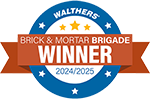
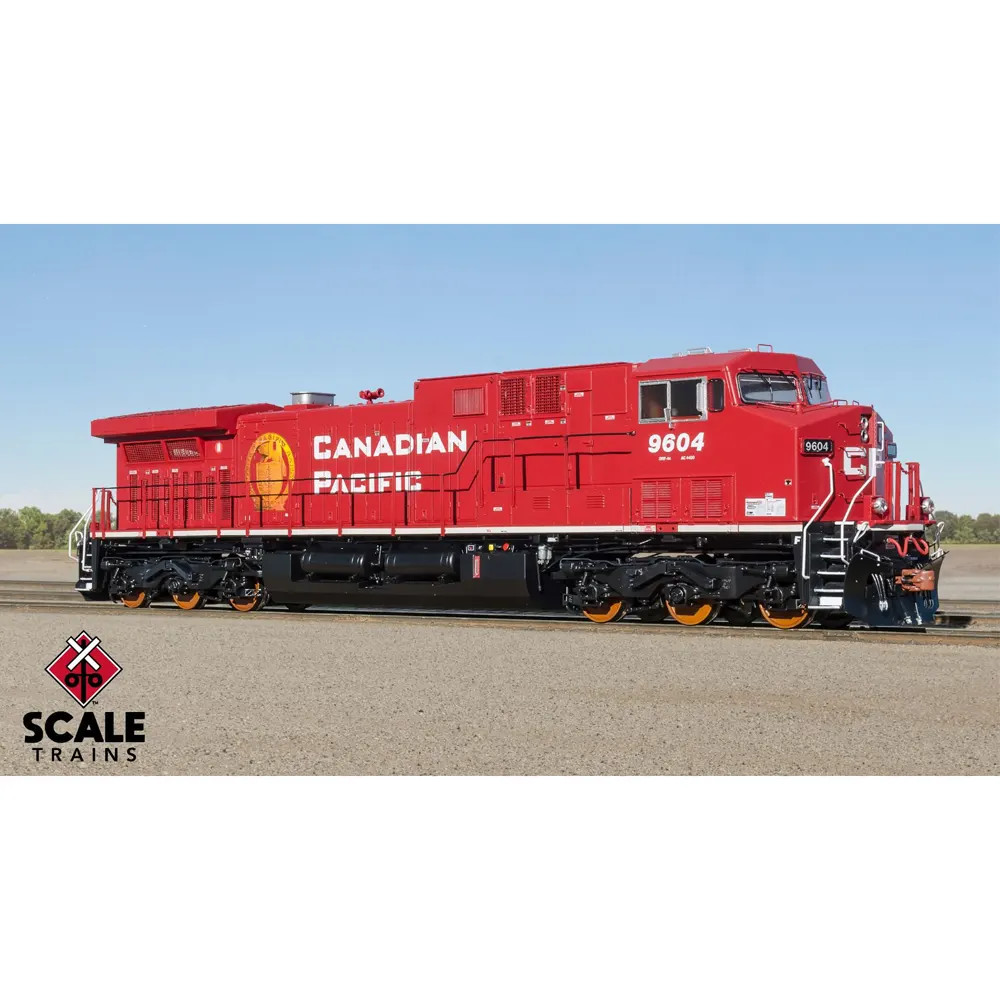
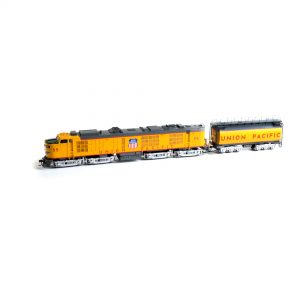
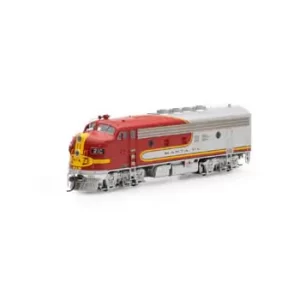
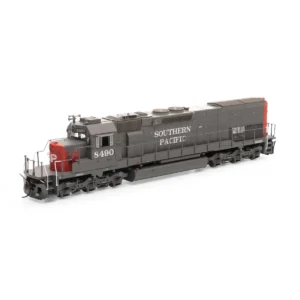
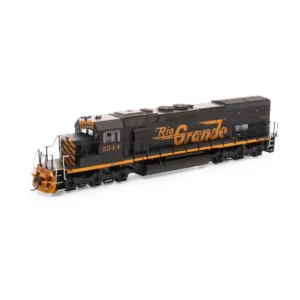
Reviews
There are no reviews yet.